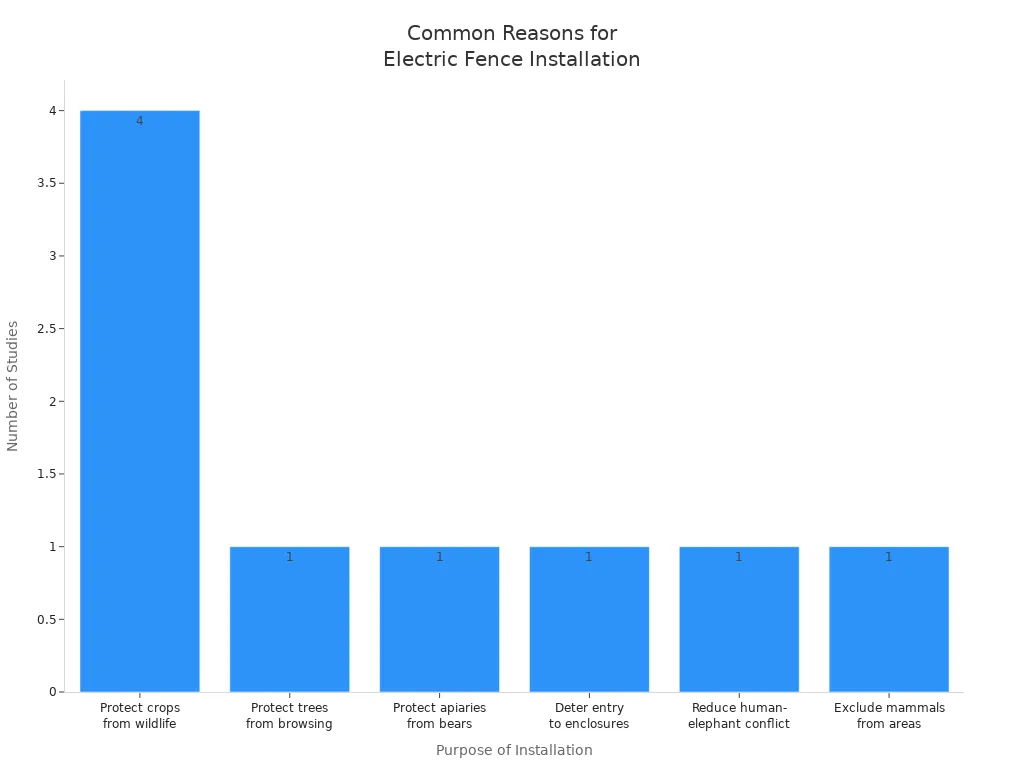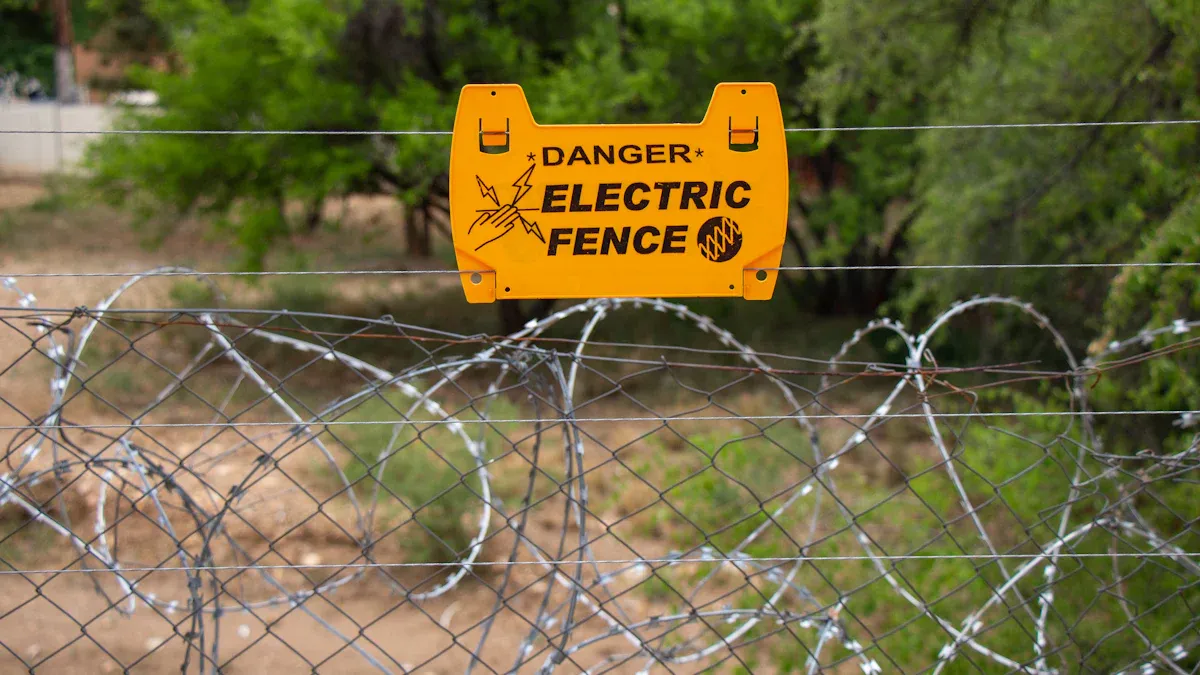
Electronic fence functions can help keep things safe. They have good points and bad points. More people and companies use electric fences now. They use them to guard land, plants, and animals. The market keeps growing each year. Smart and solar-powered systems are getting more popular everywhere.

You might see an AD with Electronic Fence Function. You may wonder if this tool is right for you. Knowing the good and bad sides helps you choose well.
Key Takeaways
Electronic fences cost less money. They are easier to set up and move than regular fences.
They help keep animals and people safe. They do this by giving a small shock and warning signals.
Solar-powered fences save energy. They work well in faraway places without power lines.
You need to check and fix the fence often. This helps the fence work the right way.
Training pets and following local laws is important. This keeps everyone safe and stops problems.
Overview
What Is Electric Fencing
You can find electric fencing in many places. People use it to keep homes, farms, and businesses safe. An electronic fence system keeps animals in or out. It also stops people from going where they should not. These systems use electricity to make a barrier. If someone or something touches the fence, it gives a small shock. This makes animals or people learn to stay away from the edge.
Electric fencing is good at finding intruders. Some systems can show where someone touched the fence within 3.6 feet. Many new fences use digital signal processing. This helps stop false alarms from things like wind or rain. You can make zones and control them with software. You can also link the fence to cameras and other security tools. Many places use these fences, like airports, power plants, and museums.
Feature/Aspect | Description |
|---|---|
Intrusion Location Accuracy | Finds where someone tries to get in, up to 3.6 feet close |
Signal Processing | Uses digital signal processing to help stop false alarms from weather |
Zoning | Software lets you set up zones for better security |
Integration | Works with IP/POE security devices and cameras |
Installation | Easy and low-cost to install |
User Configuration | Simple to set up on a computer or phone |
Markets Served | Used by government, airports, power plants, jails, museums, and homes |
Note: Some electronic fence systems use smart technology and wireless networks. These systems can watch areas without people checking all the time.
Types: Electric Underground Fences and Invisible Fences
There are different kinds of electric fencing. The main types are above-ground electric fencing, electric underground fences, and invisible fences. Above-ground electric fencing uses wires with electricity. Farmers use this to keep animals in a field.
Electric underground fences work in another way. You put a wire under the ground. This wire sends a signal from a transmitter. Your pet wears a collar. When your pet gets near the edge, the collar warns or corrects it. This type gives a strong and steady boundary. Invisible fences are a brand that works like this too. Many people use invisible fences to keep pets safe in the yard without a real fence.
Some systems use GPS instead of wires. These GPS fences make a virtual edge. You can move them, but the edge might change. This can make pets confused. Above-ground electric fencing is best for farm animals. Electric underground fences and invisible fences are best for pets at home.
Benefits

Cost-Effectiveness
Electric fencing can help you save money. Regular fences need more materials and work. A wood or vinyl fence for a small yard costs a lot. It can be $680 to $1,440. An electronic fence for the same space costs $1,200 to $2,300. This price includes setup and equipment. For bigger land, electric fencing saves even more money. Farmers and homeowners like this.
Fence Type | Cost Range (Materials + Labor) | Notes |
|---|---|---|
Traditional Fences | $7 – $26 per linear foot | Total for small 10×10 yard: $680 – $1,440 depending on material (metal, wood, vinyl) |
Electronic Fences | $1,200 – $2,300 total | Includes installation, equipment, training, warranties; costs 45% – 80% less for 1/4 acre |
You do not have to fix electric fencing as much. It needs less care than wood or metal fences. This means you save money every year.

Flexibility and Mobility
Electric fencing gives you more choices than regular fences. You can move or change the fence easily. Virtual fencing uses GPS and wireless signals. You do not need to dig or build anything. If you want to move animals, you can change the fence with a few clicks. This is good for farms and backyards.
You can make new spaces for animals fast.
You can move the fence to protect plants or gardens.
You can use electric fencing where it is hard to build, like on rocks or wet ground.
Farmers use this to keep animals safe and move them around. Homeowners can change the fence for pets without much work.
Deterrent Effect
Electric fencing helps keep out animals and people you do not want. If someone touches the fence, they get a small shock. This teaches them to stay away. On farms, this keeps animals safe from wild animals. For security, it helps stop people from coming in.
Security systems have alarms and sensors. They tell you if someone tries to mess with the fence. This helps keep your home, farm, or business safe.
Energy Efficiency
Many electric fences use solar panels for power. This lowers your energy bills and is better for the earth. Solar fences work well in places far from power lines. These fences use very little electricity. They are good for saving energy and work well.
Farmers like to use solar power for their fields. This makes electric fencing a smart choice for the planet.
Customization
You can change an electronic fence to fit what you need. Many systems let you pick how gates open, like with a keypad or phone. You can choose different gate materials, like steel or wood. Some systems let you set timers or change how fast the gate closes.
You can add cameras or alarms for more safety.
You can design the fence for any place, like homes, farms, or pools.
You can make changes for your weather or budget.
This helps you make a fence that works best for you.
Safety Features
Modern electric fencing is made to be safe. The shock is strong enough to teach, but not to hurt. Most systems use safe shocks and give a warning sound first. This helps train pets and animals without pain.
Alarm systems tell you if someone messes with the fence.
Collars for pets and animals make a sound before a shock.
Warning signs help people see the fence and stay safe.
These things make electric fencing safe for homes, farms, and businesses. You can trust it to protect your place and keep everyone safe.
Drawbacks

Maintenance Needs
You need to check and maintain electronic fences often. Grass, weeds, or branches can touch the wires and cause problems. When plants touch the fence, the system may give false alarms or stop working well. Weather can also damage parts of the fence. Rain, humidity, and lightning sometimes cause the system to fail or need a reset. If you do not install the fence correctly, it may not work as it should. You must check the wires, posts, and connections to keep the fence working. Good quality parts and careful setup help the fence last longer. Regular inspections and cleaning are important for reliable use.
Tip: Make a checklist for weekly or monthly fence checks. This helps you find and fix problems before they get worse.
Reliability Issues
Electronic fences can stop working for many reasons. You may see problems if the ground is too dry or too wet. Poor grounding or loose wires can cause the fence to fail. Weather changes, like heavy rain or storms, can make the system less reliable. Sometimes, animals or people can break the wires or move the posts. If you do not fix these issues quickly, the fence may not keep animals in or out.
Vegetation touching wires can cause false alarms or reduce the fence’s power.
Bad weather, such as rain or lightning, can damage the system or cause it to shut down.
Mistakes during installation, like poor grounding, often lead to malfunctions.
You need to inspect and repair the fence often to keep it working well.
The quality of the parts and how well you install the fence affect how long it lasts.
You should always plan for these problems and check your fence often.
Power Source Limitations
Electronic fences need power to work. If the power goes out or the battery dies, the fence stops working. This can let animals escape or allow intruders to enter your property. In remote areas, you may not have access to the power grid. You can use battery backups or solar-powered chargers to keep the fence running. These backups help during storms, blackouts, or when you need to fix the main power source.
Power outages or dead batteries make the fence useless until you fix the problem.
Battery backups and solar chargers can keep the fence working when the main power fails.
You should match the battery size and voltage to your fence system.
Place batteries in safe, dry spots and check them often.
Clean solar panels and check connections to make sure the system works well.
Regular checks and good backup plans help you avoid costly escapes or damage.
Environmental Impact
Electronic fences can change the way wildlife moves. Large animals, like deer or bears, may change their paths or learn to go around the fence. Small animals, such as rodents, can slip under the wires, but birds may leave their nests if the fence is too close. Amphibians can get stuck and dry out if the fence blocks their way. Newer fence designs use special pulses to lower electromagnetic fields, which helps protect insects and soil life.
Some systems use smart technology to turn off the fence for certain animals. Virtual fences with GPS collars do not use wires, so they do not block wildlife. You can also add sensors to watch how the fence affects the environment. During migration, you can lower the voltage or open gaps to help animals pass safely.
Note: You may need to follow local rules and get permits to make sure your fence does not harm wildlife.
Limited Physical Barrier
Electronic fences do not create a solid wall. Animals and people can cross the boundary if they ignore the warning or shock. You need to train your pets or livestock to understand the signals. Some animals learn to avoid the fence, but others may try to escape if they feel stressed or scared. Virtual fences use GPS collars to give a warning sound and a mild shock. Animals can learn to respond to the sound, which helps reduce stress.
Physical fences give a clear, solid barrier. They do not need training and can keep most animals in or out. However, they cost more and can block wildlife. Electronic fences are easier to move and can track animals, but you must watch them and train your animals well. Studies show that virtual fences work as well as electric fences in stopping escapes, but you must check the system often.
Safety and Ethical Concerns
Electronic fences can cause safety and ethical problems. Some pets, like dogs, may feel stress or fear if they get shocked near the boundary. Studies show that dogs can become anxious or aggressive after repeated shocks. Some dogs may not want to go outside or may act out near the fence. If a dog escapes, it may get shocked again when trying to return, which can keep it from coming home and put it in danger.
Dogs can get hurt if left alone with the fence.
Some dogs bark or lunge at the boundary, which can scare people or other animals.
Shocks can cause dogs to fear things near the fence, like children or cars.
Invisible fences only keep pets in; they do not keep wild animals or strangers out.
Some countries ban electronic fences because of these concerns.
You should think about other options, like a physical fence or professional training, if you worry about your pet’s safety. Using a shock collar as part of the system may add to these problems, so always consider your pet’s well-being first.
Pros and Cons
Summary Table
You need to look at the pros and cons before you choose an electronic fence. The table below shows the main points to help you decide.
Pros | Cons |
|---|---|
Cost-effective for large areas | Needs regular maintenance |
Easy to install and move | Can fail if power is lost |
Good for many settings | Not a solid physical barrier |
Customizable for your needs | May cause stress for some animals |
Can use solar power | Can affect wildlife movement |
Helps keep out intruders | May not work well in bad weather |
Tip: Think about your land, animals, and local weather when you weigh the pros and cons.
Real-World Scenarios
You can see how electronic fences work in real life by looking at different places. In a California vineyard, owners used electric fencing with strong wires to keep deer away from grape crops. This led to fewer deer in the fields, more grapes, and better sales. On a Midwest organic farm, woven wire fencing kept out rabbits and other pests. The farm saw less crop damage and used fewer chemicals, which helped them meet organic rules.
In a suburban community, people put up deer-proof fencing in parks and gardens. This stopped deer from eating plants and made the area look better for everyone. In city parks, special fencing helped control raccoon numbers. This made the parks safer for both people and animals.
These examples show that electronic fences can solve many problems. You need to think about your own needs and the pros and cons before you choose a system.
Decision Factors
Use Cases: Agriculture, Security, Residential
Think about where you want to use an electronic fence. Farmers use electronic fences to keep animals away from crops. These fences help protect plants from deer or elephants. But, if you do not take care of the fence, it may not work well. Some people use virtual fencing, like chilli string barriers, to stop wild animals. These are simple to put up and do not need much care. Virtual fencing can also help move livestock and improve grazing. Animals need training to learn where the fence is.
Electronic fences can protect big places like airports or power plants. They can warn you if someone tries to get in. At home, invisible fences let pets play safely without blocking your view. Pets need training to understand the fence. If you see an ad with electronic fence function, check if it fits your land, animals, or home.
Legal and Regulatory Issues
Check your local laws before you put up an electronic fence. Some places do not allow electric fences or have special rules. You might need a permit or must follow safety steps. In some countries, electronic fences for pets are not allowed because of animal welfare. Always read the rules in your area. If you see an ad with electronic fence function, make sure it follows the law.
Alternatives to Electric Fencing
If electronic fencing is not right for you, there are other choices. The table below shows some common options and how they compare:
Containment Type | Reliability | Cost | Installation | Area Shape | Notes |
|---|---|---|---|---|---|
Physical Fence | High | High | Complex | Any | Solid barrier, long-lasting |
Wireless Dog Fence | Medium | Medium | Easy | Circular only | Portable, limited coverage |
In-ground Dog Fence | High | Medium-High | Complex | Customizable | Needs wire burial, precise |
GPS Wireless Fence | Medium | High | Easy | Flexible | Needs subscription, portable |
Physical fences are strong but cost more money. Wireless and GPS fences are easy to move but may not work everywhere. In-ground fences take more work to set up but give better control. Always think about your land, animals, and budget before you choose.
Ad with Electronic Fence Function
You might see an ad with electronic fence function when looking for pet or farm safety. These ads talk about easy setup or smart controls. Do not just trust the ad. Check the details, like wire quality and how to install it. See if your pets need training for the system. Ads can help you find new products, but always compare and read reviews. Make sure the fence fits your needs and follows the rules.
Electronic fences can help you save money and give you more choices. They do not block your view because they are invisible. You can move them to new spots without much trouble. But you need to check the fence often to make sure it works. Watch out for power problems or broken wires. Before you pick a fence, think about your land, your animals, and the rules in your area.
Important things to think about:
Pets and livestock need training and must stay safe
You have to take care of the fence and make sure it lasts
The first price may be high, but it could save money later
Check the laws where you live and look at other options
Every place is special. Pick the fence that works for you and keeps your animals safe.
FAQ
How safe are electronic fences for pets and children?
Electronic fences give a small shock and make warning sounds. Most pets and kids are safe if you use the fence right. Always watch children near the fence and teach pets where the edge is.
Can electronic fences work during power outages?
Most electronic fences stop if the power goes out. You can use batteries or solar panels to keep them working. Check your power often so you do not have problems.
Do electronic fences harm wildlife?
Electronic fences can change how animals move around. Some small animals can go under the wires. You can use smart settings or change the fence to help protect wildlife.
What maintenance do electronic fences need?
Check wires, posts, and batteries often. Take away plants or trash touching the fence. Clean solar panels if you have them. Taking care of your fence helps it last and work well.
See Also
Choosing Between Wired And Wireless CarPlay For Silverado
Top Five Advantages And Disadvantages Of Bike CarPlay
Comparing Wireless Adapters And AI Boxes For CarPlay Value
